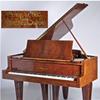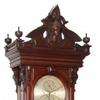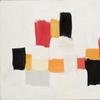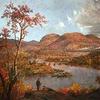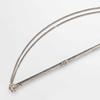Made in New York City: The Business of Folk Art
- NEW YORK, New York
- /
- January 13, 2019
MADE IN NEW YORK CITY: THE BUSINESS OF FOLK ART TO OPEN MARCH 19, 2019, AT THE AMERICAN FOLK ART MUSEUM
Exhibition to Document City’s History as Commercial and Financial Capital Through Work of Folk Artists
(New York, NY, January 10, 2019) The exhibition Made in New York City: The Business of Folk Art will be presented at the American Folk Art Museum (AFAM) from March 19 through July 28, 2019. One hundred works by 18th, 19th, and early 20th-century self-taught artists highlight the history of New York City as a financial and commercial capital. The exhibition is curated by Elizabeth V. Warren, independent curator and author of Red and White Quilts: Infinite Variety, The Perfect Game: America Looks at Baseball, and Young America: A Folk Art History, among other books. The coordinating curator is Stacy C. Hollander, deputy director for curatorial affairs and chief curator of the American Folk Art Museum.
“The exhibition Made in New York City: The Business of Folk Art could not be more timely, as it is presented when the Museum is celebrating the thirtieth anniversary of being in the center of New York’s cultural life at Lincoln Square,” says Jason T. Busch, director of the museum. “This exhibition of remarkable, richly sourced works of traditional folk art offers visitors a deeper understanding of American history and crystallizes the importance of self-taught art in the rise of the Empire City.”
New York City is and always was a city of immigrants, and those immigrants brought with them the skills and traditions of their native countries. English portrait painters, German potters, Jewish woodcarvers from Eastern Europe, and French Huguenot school teachers quickly established themselves in their new home, pursuing portrait painting, ceramics, wood carving, and stitched textiles.
“Folk art has flourished in New York City since the eighteenth century. Contrary to popular belief, it was not just a rural genre. In fact, many of the objects that have been associated with the “country” were made in the five boroughs of New York,” says Warren. “The Washburne and Fiske companies of New York, for example, manufactured many of the weathervanes that crowned barns and farmhouses throughout the country. The stoneware crocks in country stores often had their origins at Thomas Commeraw’s pottery in what is now the Lower East Side, or the MacQuoid shop on Little West 12th Street. And thousands of the carousel animals enjoyed by children across America were carved in Coney Island.”
“From its earliest days as a Dutch colony, New York was intended to operate as a commercial center. It grew from trading furs and sending the profits back to the Netherlands into a mercantile center that, by the time of the Revolutionary War, was self-sufficient enough to produce many of the objects of daily life that once had to be imported,” said Warren.
Made in New York City will tell its story from two perspectives simultaneously: “The Art of Business” focuses on the people and places that were part of the city’s thrumming commercial life. “The Business of Art” highlights the products of the artists, artisans, and manufacturers – the commercial signs, store figures, and early advertising images that they made. The exhibition will draw on the collections of a number of New York City museums, including the American Folk Art Museum, The New-York Historical Society, Cooper Hewitt Smithsonian Design Museum, Historic Richmond Town, the Metropolitan Museum of Art, and historical societies and museums in all five boroughs, as well as private collections.
The Art of Business
The people and places that were integral to the city’s financial and commercial activity are brought vividly to life through a number of portraits painted by self-taught artists as well as landscapes and seascapes that show young New York City bustling with commercial activity. Highlights from this portion of the exhibition include:
⦁ Herman Raub Engaged in Weighing Gold at the Manhattan Bank in New York, artist
unidentified (possibly “Mr. Thompson”), New York City; 1805; watercolor and pen and ink
on paper. Raub is portrayed at work, standing behind a set of scales, with a pencil behind
his ear. A poem handwritten in English and German was attached to the painting, defending his honesty and skill at his job – not only a tribute to him but a reflection on the suspicion with which banks were viewed by many in the early nineteenth century. The Manhattan Bank at New York, originally founded by Aaron Burr and others as the Manhattan Company, is the forerunner of today’s JP Morgan Chase.
⦁ Situation of America, 1848, artist unidentified; New York City; 1848; oil on wood panel. The painting depicts the Manhattan skyline as seen from the Brooklyn waterfront. The paddle wheeler Sun, steam pouring out of its smokestacks, has either unloaded its freight or is waiting to set off with a new load. A freight train, piled high with sacks and crates, is steaming away. Both allude to the abundant traffic between New York and the heartland, with goods flowing from east to west and vice versa. There was a good reason for the Sun to be docked in Brooklyn: by the middle of the nineteenth century, decaying shipping facilities on the Manhattan waterfront prompted new construction across the East River. One of the largest of these developments was completed in Red Hook in 1846, and included a steam-powered grain elevator and space for a hundred ships at a time.
⦁ Optician’s Trade Sign, E. G. Washburne & Co., 207 Fulton Street, New York City; 1915-1925; paint and gilding on zinc and iron, with glass and light bulbs. By the early twentieth century, when the Eyeglass Trade Sign was manufactured, E. G. Washburne & Co. was well established on Fulton Street in Manhattan. Traditionally, hanging signs were made of wood and were double-sided so that they could be easily visible from two directions. This sign continues that tradition, but was made of zinc and copper instead of wood. Because it is electrified, it was probably produced around 1915, when access to electricity was available, although Washburne made similar signs without light bulbs in various sizes beginning in the late nineteenth century. Washburne’s eyeglass signs were so popular that the company published a trade catalogue, E.G. Washburne & Co., Manufacturers of Optical and Jewelers Signs.
⦁ Three-Gallon Crock, made by W.A. MacQuoid and Company Pottery Works, Little West 12th Street, New York City; c. 1869; stoneware with cobalt decoration. Most of the stoneware pottery businesses were located in Greenwich Village in the mid-nineteenth century. The W. A. MacQuoid Company made the most well-known examples of stoneware in the city, notable for its “unusual and spectacular” decoration.
The Business of Art
Many of the products of artists, artisans, and manufacturers found “in the country” were thought to have been produced there. These objects were often manufactured in New York City by artists and artisans who, in the tradition of self-taught artists around the world, learned their skills by joining family businesses, apprenticing to masters, or by teaching themselves the expertise needed to produce the pieces we now consider among the core expressions of American folk art.
Highlights from this portion of the exhibition include:
⦁ Portrait of Peter Williams, artist unidentified, New York City; c. 1810-1815; oil on canvas. Peter Williams was born a slave on Beekman Street and, after being sold to a tobacco merchant, became an expert cigar maker. He was a Methodist and active in the movement to found an independent Methodist church for African Americans. In 1778, the Wesley Chapel on John Street purchased him for 40 pounds and made him its sexton. In 1796, Williams and his wife purchased their freedom, and he opened a successful tobacco store on Liberty Street.
⦁ Portrait of Dr. Benjamin Brewster Dorrance (1791-1828) and Mrs. Ann Eliza Stone Dorrance (1792-?), Ammi Phillips (1788-1865), New York City; c. 1820; oil on canvas. Phillips is one of the most prolific self-taught portrait painters, whose career spanned more than fifty years. These portraits of the married Dorrances were painted between 1820 and 1828, when the artist’s work reflected a new realism. Dr. Dorrance had an address at 69 Pump Street (now the eastern end of Canal Street) in the 1820s.
⦁ African Free School Sampler, Mary Emiston (dates unknown), New York City, 1803; silk on linen. The New York African Free School, founded in 1787, predated the city’s Free School Society (a precursor to the public school system), which was not formed until 1805. Established by the New York Society for Promoting the Manumission of Slaves, the African Free School was instituted for the children of slaves and former slaves. Beginning with about forty students in its original Cliff Street home (between Fulton and John Streets in Lower Manhattan), the system had grown to seven schools by the time New York abolished slavery in 1827.
⦁ Goddess of Liberty Weathervane, possibly by J.L. Mott Iron Works (1828-1903); Bronx, New York; 1880-1900; paint and gold leaf on copper and zinc. Though listed as a grocer in the New York City directory from 1824 to 1834, Jordan Lawrence Mott changed his profession to “stoves” and invented the original cooking stove that burned hard coal (anthracite.) He first made the stoves at his store on Water St. in Manhattan, but moved to a large piece of land at the Manor of Morrisania in the South Bronx, where he expanded into decorative iron work and weathervanes. An entire village, still known as Mott Haven, arose around the ironworks.
⦁ Baseball Player Show Figure, Samuel Anderson Robb (1851-1928), New York City; 1888-
1903; paint on wood. Show figure carvers and ship carvers once worked together in the same workshops, sharing skills and artistic sensibilities. Robb was the most famous of these carvers, and one of the innovators of the “New York style.” He was known for the wide variety of figures made primarily to be used outside tobacco shops. This baseball figure was most likely modeled after Michael J. “King” Kelly of the Boston Beaneaters team. Kelly was one of the first ball players to monetize his popularity off the field, charging $3,000 for the use of his picture. Robb’s shop was first located at 195 Canal Street, then at 114 Centre Street in Manhattan.
Exhibition credits
Major support for this exhibition is provided by the Lily Auchincloss Foundation, Inc., with additional support from Bloomberg Philanthropies, the Richard C. Von Hess Foundation, The American Folk Art Society, the David Davies and Jack Weeden Fund for Exhibitions, the Ford Foundation, Furthermore: a program of the J. M. Kaplan Fund, and the Dorothea and Leo Rabkin Foundation. Public funds were provided by the New York City Department of Cultural Affairs in partnership with the City Council, and the New York State Council on the Arts with the support of Governor Andrew M. Cuomo and the New York State Legislature.
About the American Folk Art Museum
Founded in 1961, the American Folk Art Museum is the premier institution devoted to the aesthetic appreciation of traditional folk art and creative expressions of contemporary self-taught artists from the United States and abroad. The museum preserves, conserves, and interprets a comprehensive collection of the highest quality, with objects dating from the eighteenth century to the present.


270x400_c.jpg)




